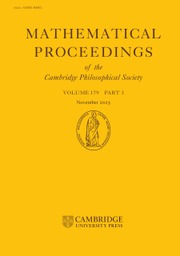No CrossRef data available.
Article contents
On off-diagonal Ramsey numbers for vector spaces over  $\mathbb{F}_{2}$
$\mathbb{F}_{2}$
Published online by Cambridge University Press: 25 June 2025
Abstract
For every positive integer d, we show that there must exist an absolute constant  $c \gt 0$ such that the following holds: for any integer
$c \gt 0$ such that the following holds: for any integer  $n \geqslant cd^{7}$ and any red-blue colouring of the one-dimensional subspaces of
$n \geqslant cd^{7}$ and any red-blue colouring of the one-dimensional subspaces of  $\mathbb{F}_{2}^{n}$, there must exist either a d-dimensional subspace for which all of its one-dimensional subspaces get coloured red or a 2-dimensional subspace for which all of its one-dimensional subspaces get coloured blue. This answers recent questions of Nelson and Nomoto, and confirms that for any even plane binary matroid N, the class of N-free, claw-free binary matroids is polynomially
$\mathbb{F}_{2}^{n}$, there must exist either a d-dimensional subspace for which all of its one-dimensional subspaces get coloured red or a 2-dimensional subspace for which all of its one-dimensional subspaces get coloured blue. This answers recent questions of Nelson and Nomoto, and confirms that for any even plane binary matroid N, the class of N-free, claw-free binary matroids is polynomially  $\chi$-bounded.
$\chi$-bounded.
Our argument will proceed via a reduction to a well-studied additive combinatorics problem, originally posed by Green: given a set  $A \subset \mathbb{F}_{2}^{n}$ with density
$A \subset \mathbb{F}_{2}^{n}$ with density  $\alpha \in [0,1]$, what is the largest subspace that we can find in
$\alpha \in [0,1]$, what is the largest subspace that we can find in  $A+A$? Our main contribution to the story is a new result for this problem in the regime where
$A+A$? Our main contribution to the story is a new result for this problem in the regime where  $1/\alpha$ is large with respect to n, which utilises ideas from the recent breakthrough paper of Kelley and Meka on sets of integers without three-term arithmetic progressions.
$1/\alpha$ is large with respect to n, which utilises ideas from the recent breakthrough paper of Kelley and Meka on sets of integers without three-term arithmetic progressions.
MSC classification
Information
- Type
- Research Article
- Information
- Mathematical Proceedings of the Cambridge Philosophical Society , Volume 179 , Issue 2 , September 2025 , pp. 503 - 518
- Copyright
- © The Author(s), 2025. Published by Cambridge University Press on behalf of Cambridge Philosophical Society

